Contents
ABSTRACT
The growth of research in the field of public administration in Indonesia is substantial, but there is no comprehensive study that examines its evolution and future trajectory. Using a bibliometric approach, the purpose of this study is to investigate the thematic evolution and international collaboration in the field of public administration in Indonesia. To accomplish this objective, we analyzed a dataset comprised of publications from 50 leading public administration journals indexed in the Scopus database using a bibliometric technique. This method permits us to perform statistical analysis on bibliographic data in order to identify and define trends and patterns in research on public administration in Indonesia. The findings demonstrate significant shifts in research emphasis over time, with the emergence of new themes and the continued relevance of older ones. The collaboration map reveals significant collaboration with Bangladesh, Ethiopia, Malawi and Mozambique, among others, including Australia, the United Kingdom and the Netherlands. Implications of this study include the significance of understanding the dynamics and evolution of public administration research, as well as the role of international collaboration in advancing knowledge in this field. This research also lays the groundwork for future studies to explore specific themes and collaboration dynamics in greater detail within the field of public administration in Indonesia.
INTRODUCTION
Public administration plays a crucial role in the structure and operation of state institutions. Public administration refers to the implementation of government-created laws, regulations and policies, as well as the enhancement of the efficacy and effectiveness of the delivery of public services.[1–3] The effectiveness of public administration has a significant impact on governance, accountability and the enhancement of the quality of people’s lives. Therefore, a comprehensive comprehension of this sector is crucial for the sustainable development of nations and societies.
As the country with the 4th-largest population and the fastest-growing economy in the world, Indonesia presents a unique and challenging environment for public administration research.[4–7] Rapid growth and extensive geographical, demographic and sociocultural diversity present public administration with numerous challenges and opportunities.[6,7] Numerous studies have examined the Public administration research in Indonesia, which faces challenges in resource management, public service delivery and policy implementation.[5–7]
Although the quantity of research on public administration in Indonesia has increased, more systematic efforts are still required to map and analyze this corpus of research. Understanding the structures, patterns and trends of this research is crucial for determining how far public administration research in Indonesia has progressed and how these developments influence and are influenced by the larger social, political and economic context.[8–10] Therefore, this study will utilize bibliometric analysis to identify these patterns. Multiple previous studies in the realm of public administration have utilized comparable methodologies.[11] performed a bibliometric analysis on global public administration, utilizing data from the Web of Science database.[11] In the same way,[12] performed a similar examination, but with the additional application of Vos Viewer to obtain more recent findings. Others,[13] also conducted a scientometric analysis of the performance management literature in the field of public administration, approaching it from a different standpoint.[14]
Here, by applying bibliometric analysis to the corpus of public administration research in Indonesia with Bibliometrix tools and Scopus Database, this study seeks to close this knowledge gap. Bibliometric analysis is a quantitative method for mapping and comprehending the structure and patterns of a research corpus.[15–17] This method is used to identify the major themes and trends in research, the major protagonists and their patterns of collaboration, as well as Indonesia’s position and role in global public administration research.[18]
In the current study, we aim to answer several important research concerns. First, how has the distribution of publications on public administration in Indonesia changed over time? What are the primary themes and topics of this study and how have they changed over time? Who are the primary participants in this study, both individually and institutionally? And finally, how was the research collaboration network founded and developed?
This study is significant because it contributes to our knowledge of the evolution of public administration research in Indonesia. In addition, it can assist researchers, practitioners and policymakers in understanding the major trends, themes and actors in current research, as well as in identifying understudied or promising research areas. In addition, by identifying collaboration networks in this research, we can obtain insight into the structure and dynamics of research collaboration in this field, which can aid in fostering additional research collaboration and expanding research capacity.
METHODOLOGY
This study utilizes a bibliometric methodology to analyze the scholarly publications on public administration in Indonesia. The bibliometric method is a statistical technique used to analyze and interpret bibliographic data with the purpose of identifying patterns and trends in scientific publications.[18,19] Before we took into data mining, the first step of this method involves searching the 50 top-ranked journals based on their citation score in the Scopus database on “Sources” feature. We have compiled a comprehensive list of 50 prominent journals on the subject area in public administration. This step is also consistent with prior research that conducted bibliometric analyses on various prominent journals.[20,21]
The initial phase of this investigation is data collection. We conducted a thorough search of Scopus, a comprehensive database of scientific literature. These search terms were used to identify relevant articles: SRCTITLE (“Administrative Science Quarterly” OR “Journal of European Public Policy” OR “Policy Studies Journal” OR “Policy and Society” OR “Public Administration Review” OR “Journal of Public Administration Research and Theory” OR “Public Management Review” OR “Administrate si Management Public” OR “Review of Public Personnel Administration” OR “Policy Sciences” OR “Information Technology for Development” OR “Criminology and Public Policy” OR “Journal of Public Relations Research” OR “Journal of Urban Management” OR “Policy and Internet” OR “Regulation and Governance” OR “Public Policy and Administration” OR “Policy and Politics” OR “American Review of Public Administration” OR “Policy Design and Practice” OR “Educational Administration Quarterly” OR “Governance” OR “European Policy Analysis” OR “Government and Opposition” OR “Journal of Policy Analysis and Management” OR “Human Resources for Health” OR “Public Administration” OR “Environment and Planning C: Politics and Space” OR “Journal of Social Policy” OR “Administration and Society” OR “International Review of Administrative Sciences” OR “Science and Public Policy” OR “Information Polity” OR “Research and Politics” OR “Social Policy and Administration” OR “Perspectives on Public Management and Governance” OR “Journal of Benefit-Cost Analysis” OR “Risk, Hazards and Crisis in Public Policy” OR “Transforming Government: People, Process and Policy” OR “Journal of Information Technology and Politics” OR ” Journal of Chinese Governance” OR “Area Development and Policy” OR “Asia and the Pacific Policy Studies” OR “Policy Insights from the Behavioral and Brain Sciences” OR “Public Performance and Management Review” OR “Education Inquiry” OR “Globalizations” OR “Politics and Governance” OR “Voluntas” OR “Critical Policy Studies”) AND (LIMIT-TO (AFFILCOUNTRY, “Indonesia”). Upon inputting the search query. We conducted a screening process by establishing specific criteria for the inclusion of documents. These criteria focused on selecting articles only in English within the field of social sciences. Additionally, we screened the authors/affiliations and excluded any journals that have zero documents. The process of inclusion and exclusion was applied in accordance with the methodology employed in order to narrow down the search results and avoid excessive breadth following previous studies.[22,23] The data was collected on May 23, 2023 and yielded a total of 122 documents.
This information was then imported into the Bibliometrix software[24] for analysis. In the phase of analysis, we conducted a descriptive analysis to gain an overview of the data, including the distribution of publications over time, authors and affiliates. In addition, we conducted co-citation network analysis to determine the relationships between authors, affiliations and nations.[24] In addition, a thematic evolution analysis was conducted to identify shifts in research emphasis over time. This is accomplished by mapping keywords and observing how their distribution fluctuates over time, following previous studies on the same approach.[25] Finally, we created a collaboration map to visualize collaboration networks between Indonesian and international writers and institutions. This allows us to observe how Indonesian and international researchers collaborate in the field of public administration.[24]
RESULTS
Table 1 provides in-depth bibliometric insights into public administration research in Indonesia. This study investigates a total of 122 documents with a total of 6189 references, utilizing data from 50 prestigious journals over a lengthy time span, from 1968 to 2023. With an annual growth rate of 4.62%, the number of publications has increased significantly during this time period. With an average document age of 5.52 years, it is clear that this research field is dynamic and expanding.
| Description | Results |
|---|---|
| Main information about data | |
| Timespan | 1968:2023 |
| Sources (Journals, Books, etc.,) | 30 |
| Documents | 122 |
| Annual Growth Rate % | 4.62 |
| Document Average Age | 5.52 |
| Average citations per doc | 9.967 |
| References | 6189 |
| Document contents | |
| Keywords Plus (ID) | 333 |
| Author’s Keywords (DE) | 480 |
| Authors | |
| Authors | 386 |
| Authors of single-authored docs | 18 |
| Authors Collaboration | |
| Single-authored docs | 22 |
| Co-Authors per Doc | 3.52 |
| International co-authorships % | 52.46 |
| Document Types | |
| article | 122 |
Table 1 also displays the dissemination and influence of research. With an average of 9,967 citations per document, the research in this field has a significant impact and relevance. This study also identified a total of 333 keywords from Identifiers (ID) Plus and 480 keywords from (descriptors) DE authors that represent the study’s primary focal areas. This investigation revealed that there were 386 authors, with 18 authors publishing a single document, in terms of author collaboration. With an average of 3.52 authors per document and a % of international authors collaborating of 52.46%, this demonstrates that research in this field is collaborative and frequently involves contributions from authors from various countries. All of the documents reviewed in this study are articles, indicating that this is the most prevalent form of research dissemination in the field of public administration in Indonesia.
Research and citation growth in the discipline of public administration in Indonesia
Figure 1 measures the number of articles published annually as a measure of the growth of knowledge and research in this field. In its early years, between 1968 and 2002, scientific article production was scarce. In addition to 2003, there were single publications in 1968, 1982 and 1993. During this time period, research output grew very slowly, possibly a reflection of the early phases of the field’s development in Indonesia. Beginning in 2006, however, there was an increase in article production. In that year, three articles were published, followed by two in 2008 and three more in 2009. It is evident that 2006 marked a turning point in the annals of public administration research in Indonesia knowledge production. This rate of growth has persisted, albeit with slight fluctuations and will reach a maximum of 20 articles in 2022. Despite a minor decline to 12 articles in 2023, this indicates that research activity in this field remains high.
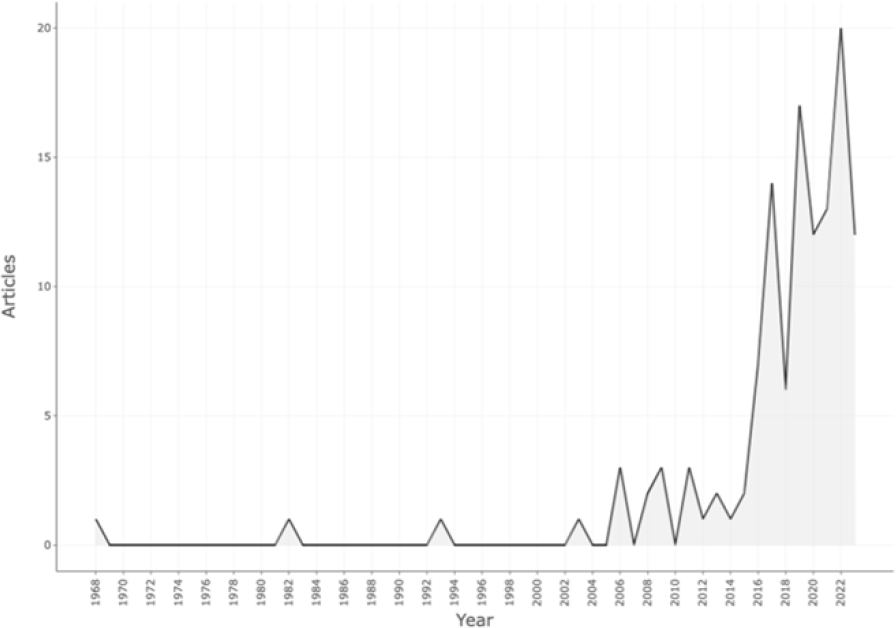
Figure 1:
Annual Scientific Production.
Figure 2 examined the average annual citation rate, which can be used as a measure of the impact and significance of research in this field. Initially, despite the fact that several articles were published between 1968 and 1982, none of them were cited. In 1993, the average number of citations per article increased, but the annual citation rate remained extremely low, at 0.03. In 2003, however, there was a significant increase. The average number of citations received by articles published in that year was 88, with an average of 4.40 citations per year. This indicates that research in this field is beginning to attract more interest and influence. After that, the average number of citations per article fluctuated with a downward trend. For instance, the average number of citations per article in 2006 was 24.67, declined to 10.00 in 2011 and then reached a low of 1.10 in 2022. Consider that it typically takes time for quotations to accumulate, so newer articles may not yet demonstrate their complete impact. However, the decline in average citations per article suggests that, despite the increase in research output in this field, not all of it has had a significant impact or relevance.
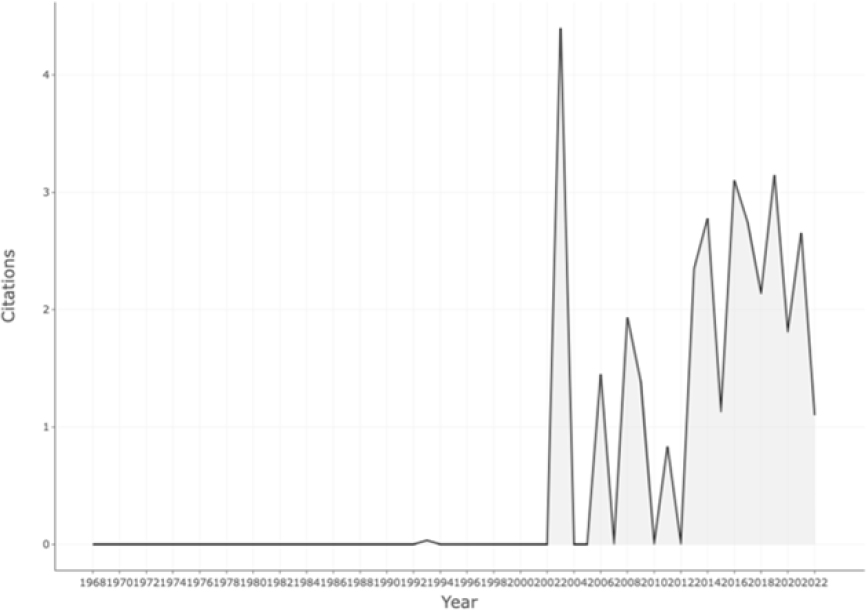
Figure 2:
Average Citation Per Year.
Relevant sources and sources impact
This study analyses the most pertinent sources in this discipline (Table 2). This source is evaluated based on the number of articles it published during the time frame of the study. “Human Resources for Health” headed the list with sixteen published articles. In addition, this source has a substantial local influence with a h index of 8, a g index of 16 and a total of 278 citations. In addition, “Transforming Government: People, Process and Policy” and “Asia and the Pacific Policy Studies” contributed significantly to the production of knowledge in this field by publishing 14 and 12 articles, respectively.
| Journals | Articles |
|---|---|
| Human Resources for Health. | 16 |
| Transforming Government: People, Process and Policy. | 15 |
| Asia And the Pacific Policy Studies. | 12 |
| International Journal of Public Administration. | 10 |
| Administrative Si Management Public. | 9 |
| Asia Pacific Journal of Public Administration. | 7 |
| Public Administration and Development. | 7 |
| International Journal of Public Policy and Administration Research. | 5 |
| International Review of Administrative Sciences. | 4 |
| Politics And Governance. | 4 |
With relatively high h and g indices and a substantial number of total citations, these sources also have a significant local impact (Table 3). Despite the fact that “Human Resources for Health” and other sources have a significant local impact, there are other sources with fewer articles that still have a considerable impact. For instance, “Public Administration and Development” has only published seven articles but has an h index of 5 and 183 total citations. This demonstrates that the importance of a source is not necessarily proportional to the number of articles it publishes. In some instances, sources with fewer articles can be more influential.
| Journals | h_index |
|---|---|
| Human Resources for Health. | 9 |
| Transforming Government: People, Process and Policy. | 8 |
| Asia and the Pacific Policy Studies. | 7 |
| International Journal of Public Administration. | 5 |
| Public Administration and Development. | 5 |
| Administrative Si Management Public. | 4 |
| International Review of Public Administration. | 4 |
| Asia Pacific Journal of Public Administration. | 3 |
| Politics and Governance. | 3 |
| Environment And Planning C: Politics and Space. | 2 |
Relevant author and author impact
Figure 3 visualises the significance of the author’s contribution to this discipline. Authors play a crucial role in the advancement of knowledge in a particular field and are typically evaluated based on the number of articles they produce and their local influence.
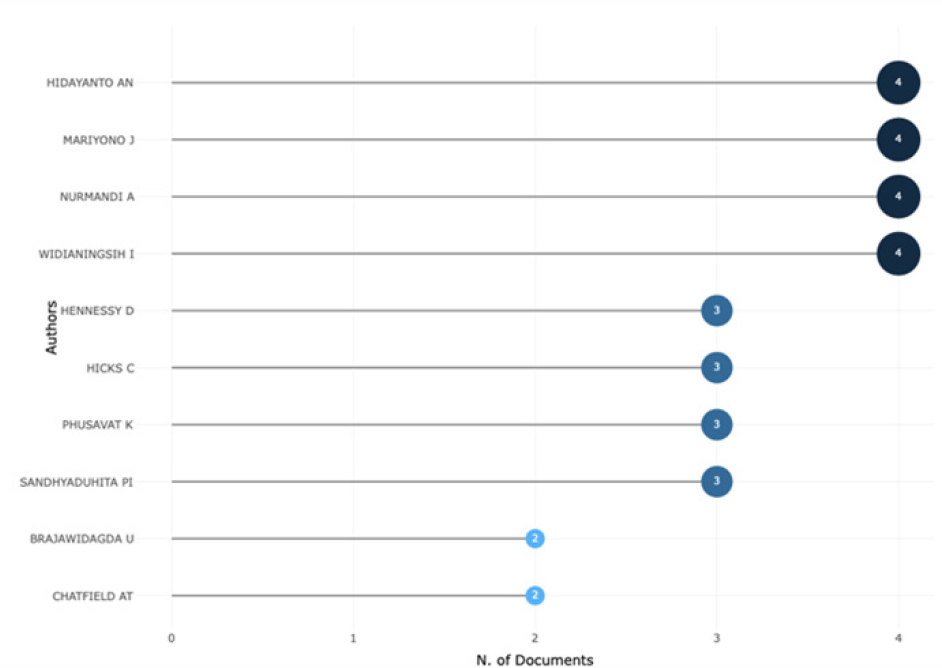
Figure 3:
Relevant authors.
During the research period (Figure 4), Achmad Nizar Hidayanto, Joko Mariyono, Achmad Nurmandi, Ida Widianingsih each authored four articles, making them the most prolific authors in this discipline. However, Achmad Nizar Hidayanto and Achmad Nurmandi also have a notable local impact, as evidenced by their h indexes of 4 and cumulative citation counts of 80 and 93, respectively. Other authors such as Deborah Anne Hennessy, Caloryn M Hicks and Kongkiti Peter Phusafat have written slightly fewer articles (3 each), but their h-indexes and cumulative citation counts indicate that they have a significant local impact (Figure 6). This indicates that an author’s output (number of articles) is not always proportional to their influence (number of citations). Some authors may publish fewer articles, but their impact is greater because their work is cited more frequently by other authors.
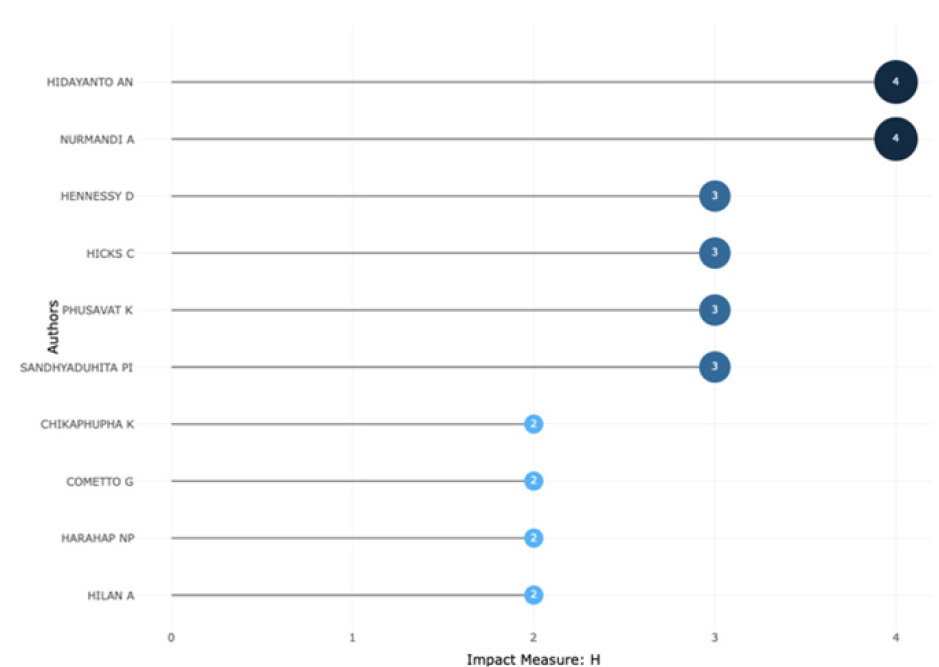
Figure 4:
Author impact.
Profile of affiliation
In Figures 5 and 6, several institutions appear to have contributed the most to the literature on public administration research in Indonesia, according to this study. Gadjah Mada University is the institution with the most contributions to this investigation, having produced ten articles. Both Yogyakarta Muhammadiyah University and the University of Indonesia have published nine articles, tying for second place.
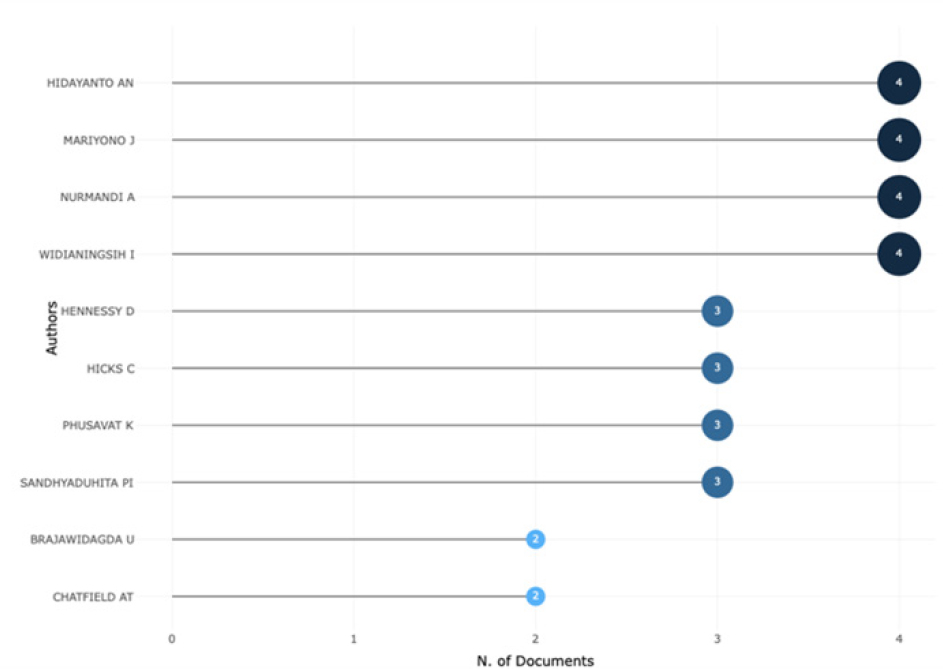
Figure 5:
Profile of institution.
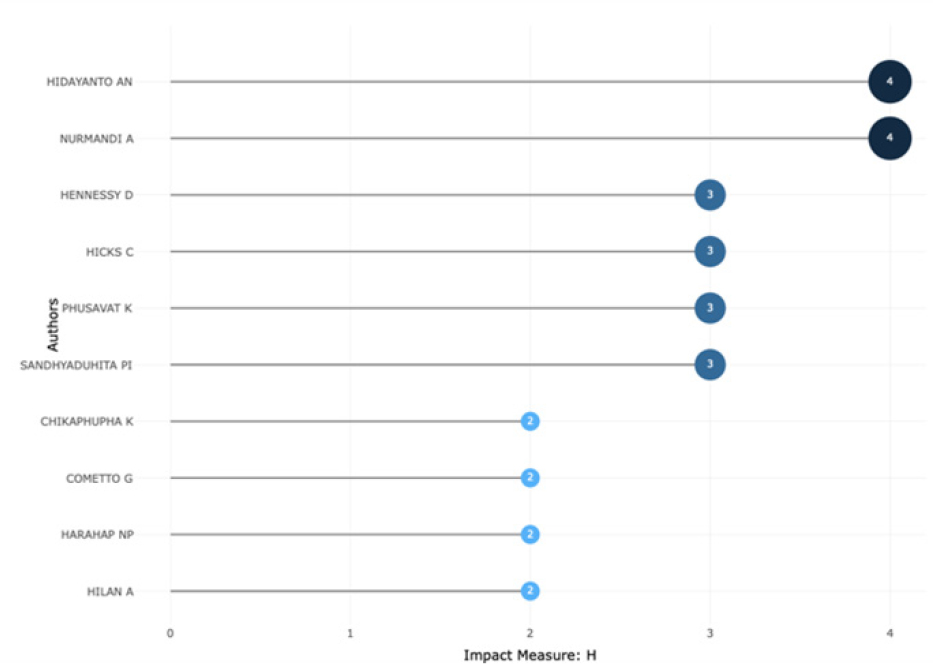
Figure 6:
Productivity.
The Ministry of Health and the University of Indonesia have each produced eight articles, demonstrating that both government institutions and universities play an essential role in the production of this research. Changes over time indicate that these institutions have substantially increased their output in recent years. In 2016, Universitas Gadjah Mada only published one article, but in 2023, the university has published ten. This demonstrates that this institution has prioritized public administration research.
Articles with the most citations
Table 4 comprehends the globally most-cited documents. This can help determine which research has had a substantial impact on public administration research in Indonesia.
| Paper | Author(s) | Total Citations | TC per Year | Normalized TC |
|---|---|---|---|---|
| Decentralisation and forest management in Latin America: Towards a working model. | Larson AM[52] | 88 | 4.19 | 1.00 |
| From governance to government: The strengthened role of state bureaucracies in forest and agricultural certification. | Giessen L, Burns S, Sahide MAK, Wibowo A.[61] | 79 | 9.88 | 3.64 |
| Salaried and voluntary community health workers: Exploring how incentives and expectation gaps influence motivation. | Ormel H, Kok M, Kane S, Ahmed R, Chikaphupha K, Rashid SF, et al.[26] | 60 | 12.00 | 4.77 |
| Human resources for health at the district level in Indonesia: The smoke and mirrors of decentralization. | Heywood PF, Harahap NP.[62] | 49 | 3.27 | 2.53 |
| The relation of e-government quality on public trust and its impact on public participation. | Nulhusna R, Sandhyaduhita PI, Hidayanto AN, Phusavat K.[54] | 48 | 6.86 | 2.92 |
| Are government employees adopting local e-government transformation?: The need for having the right attitude, facilitating conditions and performance expectations. | Batara E, Nurmandi A, Warsito T, Pribadi U.[63] | 37 | 5.29 | 2.25 |
| Political accountability, fiscal conditions and local government performance – Cross-sectional evidence from Indonesia. | Eckardt S.[64] | 31 | 1.94 | 1.07 |
| Factors Influencing SME Tax Compliance: Evidence from Indonesia. | Inasius F.[65] | 29 | 5.80 | 2.30 |
| Distribution of health care resources in Mongolia using the Gini coefficient. | Erdenee O, Paramita SA, Yamazaki C, Koyama H.[66] | 28 | 4.00 | 1.70 |
| Statistics on Ethnic Diversity in the Land of Papua, Indonesia. | Ananta A, Utami DRWW, Handayani NB.[67] | 28 | 3.50 | 1.29 |
In this study, we found that a 2003 paper titled “Decentralisation and forest management in Latin America: Towards a working model ” by Larson[27] has received 88 citations, with an average of 4.19 citations per year, indicating that its influence has remained constant since its publication. In contrast, the Normalized Total Citations (NTC) score for this paper is 1, indicating that it receives fewer citations per year than the average of the other papers in this study. The paper with the highest NTC score on this list is ” Salaried and voluntary community health workers: Exploring how incentives and expectation gaps influence motivation ” by Ormel et al.,[26] which has received a total of 60 citations and an annual average of 12 citations, giving it a score of 4.77. This indicates that, compared to other papers in this study, this one has a very high annual citation rate. Here, Ormel et al., discuss about how incentives affect Community Health Worker (CHW) motivation and performance.[26] They provide insight into CHW motivation in public health and public management, which is relevant to public administration. Otherwise, the last high citation is the discussion about statistical insight into ethnic diversity in Papua, Indonesia, regional policy, population management, migration and socioeconomic dynamics.[27] This article can inform public administrators and policymakers about the data needed for effective governance, development planning and addressing public administration issues like marginalization, transmigration and ethnic relations.
Subject Area
The data presents the research publications in the field of public administration in Indonesia, categorized by subject area. As shown in Figure 7, the social sciences comprising all the findings (122 publications), indicates that research in public administration draws on sociology, political science and other related fields. The latest publications in this field are the study to redefines speed, ethics and fusion to discuss how a hybrid approach to public administration in the latest discourse.[28] The field of Business, Management and Accounting has 30 publications that focus on enhancing the understanding and improvement of public administration through managerial and organizational perspectives. The field of Computer Science, with its 20 published works, explores the incorporation of technology into public administration, highlighting the interconnectedness of information technology and governance. The 19 publications in the fields of Economics, Econometrics and Finance indicate a concentration on economic and financial matters within the realm of public administration. Medicine, with a total of 16 published works, focuses on promoting health and suggests research in the field of healthcare-public administration. The field of Decision Sciences, with a focus on analytical methods, primarily examines decision-making in the public sector. It has a total of 15 publications. The study that also contributes in this subject area is show the importance of strong accountability systems and evaluative frameworks that account for organizational and local culture and the many variables that affect decisions.[28,29] There has been a noticeable increase in awareness and research attention towards the environmental aspects of public administration, as evidenced by the publication of 8 articles in the field of Environmental Science. One of them is discusses collaborative rural planning, where power dynamics affect the planning process and product, using the village planning process in Pematang Tengah, Indonesia, where the agrarian village community, deliberative bureaucrats and other stakeholders create development rural planning projects.[30] Research in public administration in Indonesia is characterized by its interdisciplinary nature, as it tackles intricate governance issues by drawing upon various academic disciplines.
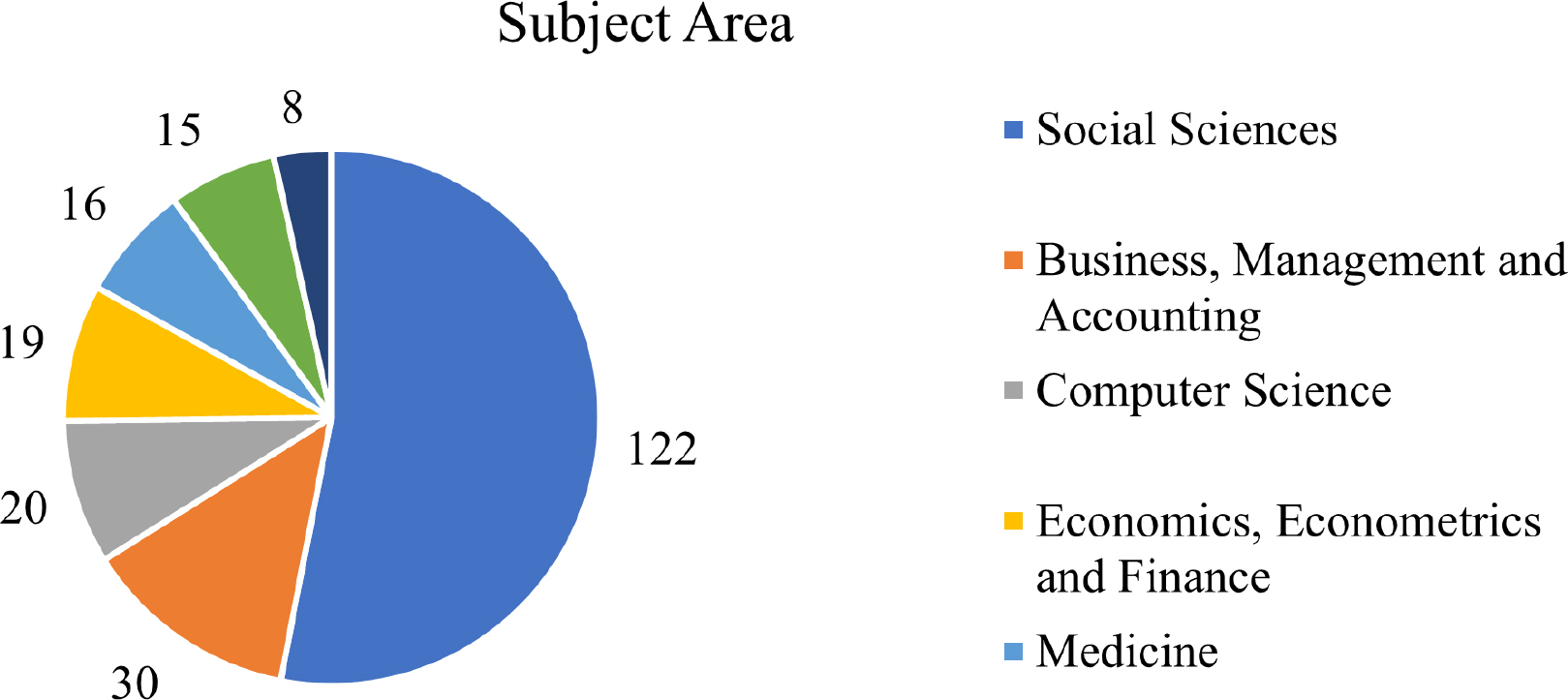
Figure 7:
Subject Area of Research.
Funding Sponsor
Figure 8 illustrates the funding sponsors supporting public administration research in Indonesia. Lembaga Pengelola Dana Pendidikan (Indonesian Endowment Fund for Education/LPDP) and Universitas Indonesia have each taken the lead in securing funding for academic research on three separate occasions, showcasing their dedication to this field. One of research funded by LPDP is discussing about the exploring the configurations of public-private partnerships in solid waste management in Indonesia.[31] The collaboration between the Australian Government, Australian National University, Australian Research Council and Department of Foreign Affairs and Trade, Australian Government is evidenced by the allocation of eight grants, which highlight their shared interest in studying Indonesian public administration. Some of research that funded by Australian Government is concerned in health policy. One of them is about the examination the historical background of the universal healthcare and its correlation with regional tobacco taxes.[43] Others, the discussion about the health worker labor market, including their preferences and concerns and doctors’ talents, competence and performance (the ‘know-do gap’)[32] Two research projects are funded by each of the European Commission, Seventh Framework Programme, UK Research and Innovation, Universitas Gadjah Mada and World Health Organisation (WHO). This showcases a diverse array of funding sources, ranging from international to national. The presence of various funding sponsors demonstrates the worldwide significance of public administration research in Indonesia and the collective endeavors and alliances aimed at promoting knowledge and comprehension.
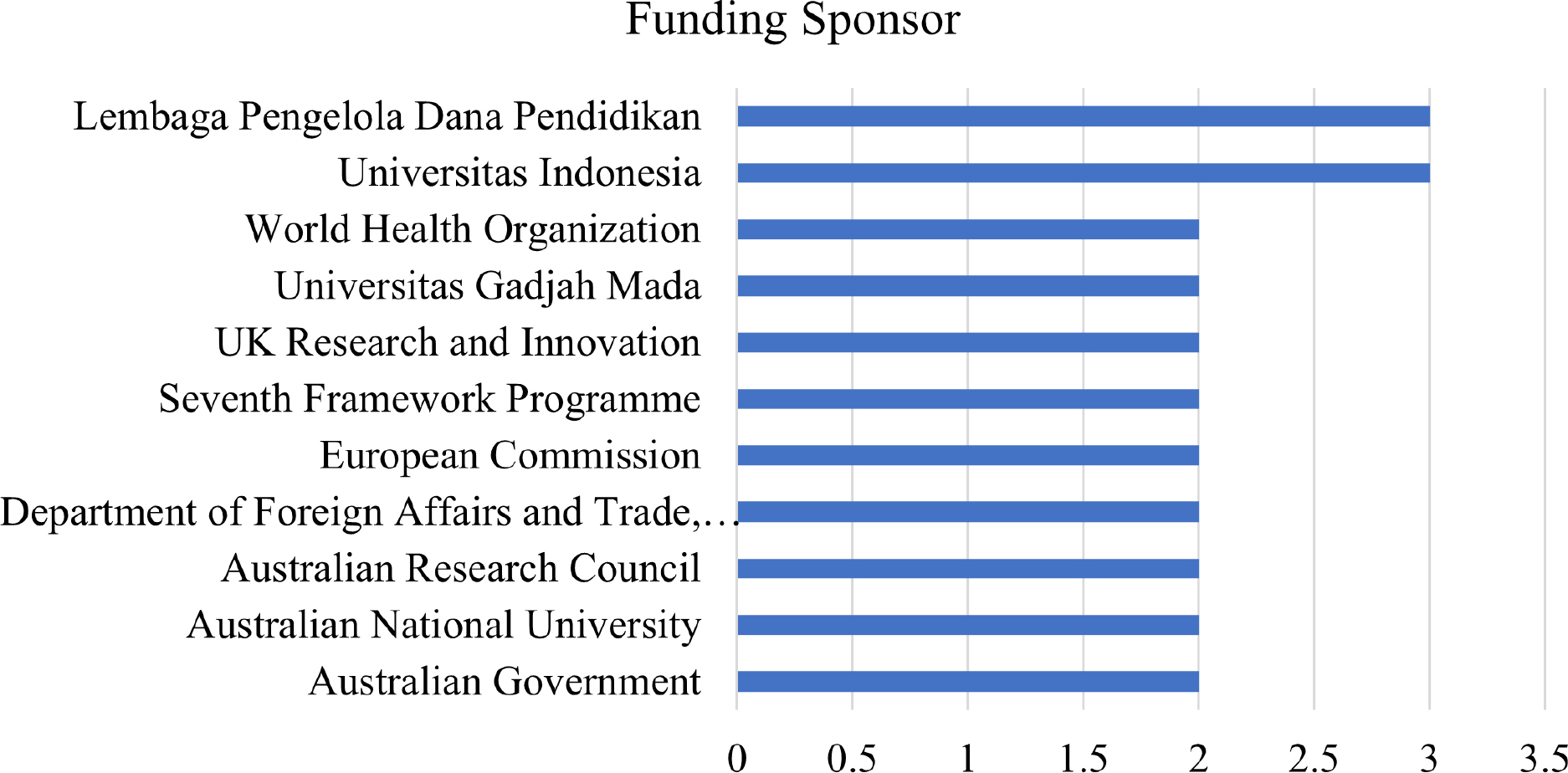
Figure 8:
Funding Sponsor of Research.
Trending topics
Figure 9 maps trends in research on public administration in Indonesia can be enhanced by analyzing the frequency of words and phrases in published papers.
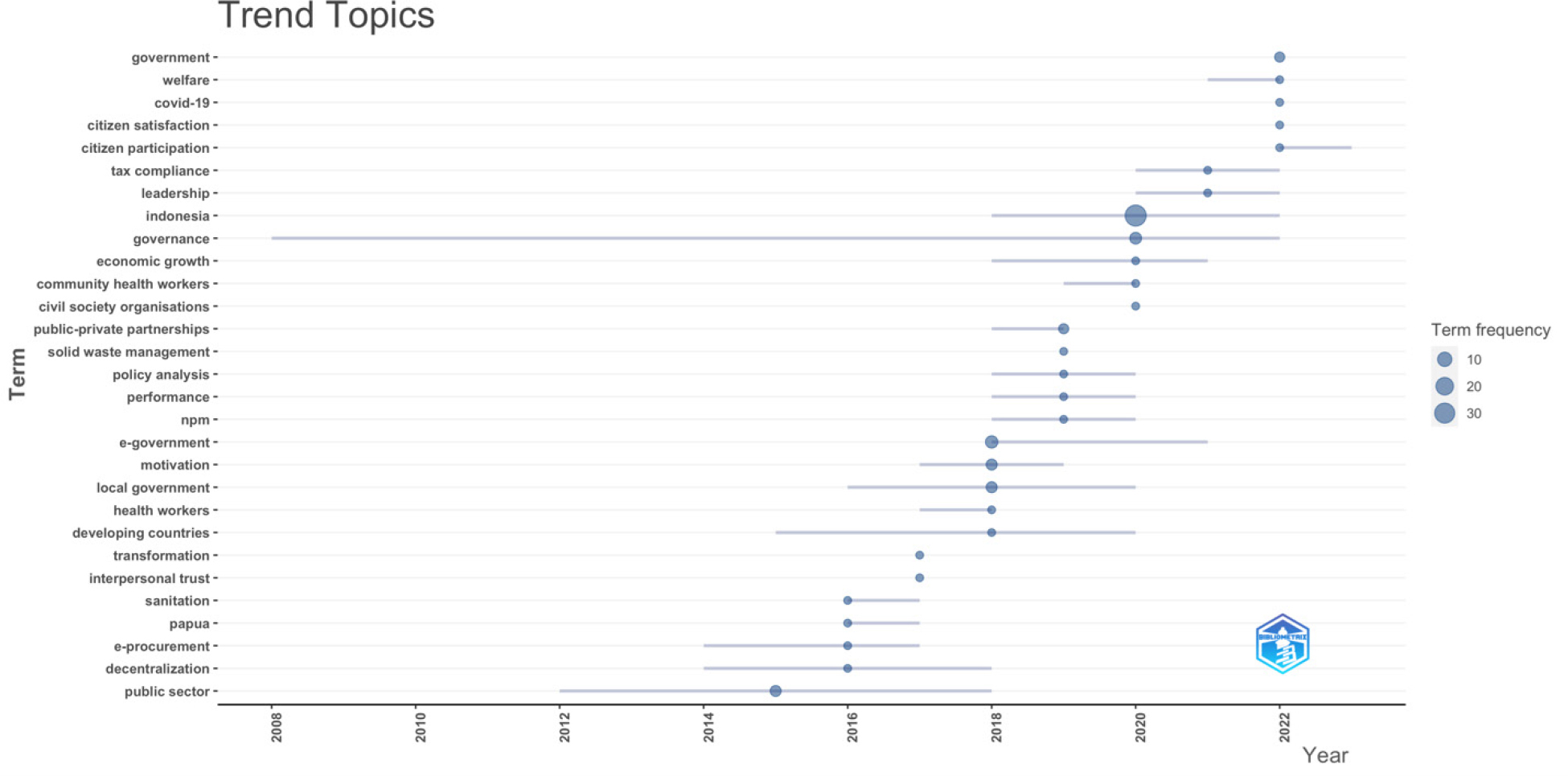
Figure 9:
Trend topics.
Utilizing bibliometric tools, the examination of author keywords reveals various trends in Indonesian public administration research throughout the years. The term “public sector” has been mentioned on four occasions between 2012 and 2018. The concept of “decentralization” is evident in the years 2014, 2016 and 2018, suggesting a continuous fascination with the distribution of administrative power. The terms “E-procurement” and “Papua” were mentioned twice in both 2014 and 2016, suggesting a growing focus on studying electronic procurement and the regional context of Papua. In the years 2018 to 2021, there were six instances where the term “e-government” was prominently used, suggesting a sustained effort to investigate and implement electronic governance methods. The consistent focus on keywords such as “local government,” “motivation,” and “developing countries” indicates a sustained interest in research themes that are related to sustainability. One of study contributes in this trend topics is the discuss about whether actor network configurations help or hinder local natural resource governance in decentralized Indonesian political system.[33] The field of public administration research demonstrates its adaptability to contemporary concerns, as evidenced by the notable increase in the usage of keywords such as “COVID-19,” “citizen participation,” and “government” in 2022. Those trends rising up as pandemic hits globally since 2020. A notable research in these trends provided by explaination the technology acceptance model in the online public sector and the key factors that affect it, especially in light of the COVID-19 pandemic’s massive and intensive increase in technology use in public administration, moving public services online.[34] The analysis of author keywords over time reveals the evolution of public administration research in Indonesia, demonstrating both persistent themes and emerging subjects that mirror societal and global transformations.
Research clusters
Four major clusters are discernible within the topic co-occurrence network of research on public administration in Indonesia in Figure 10.
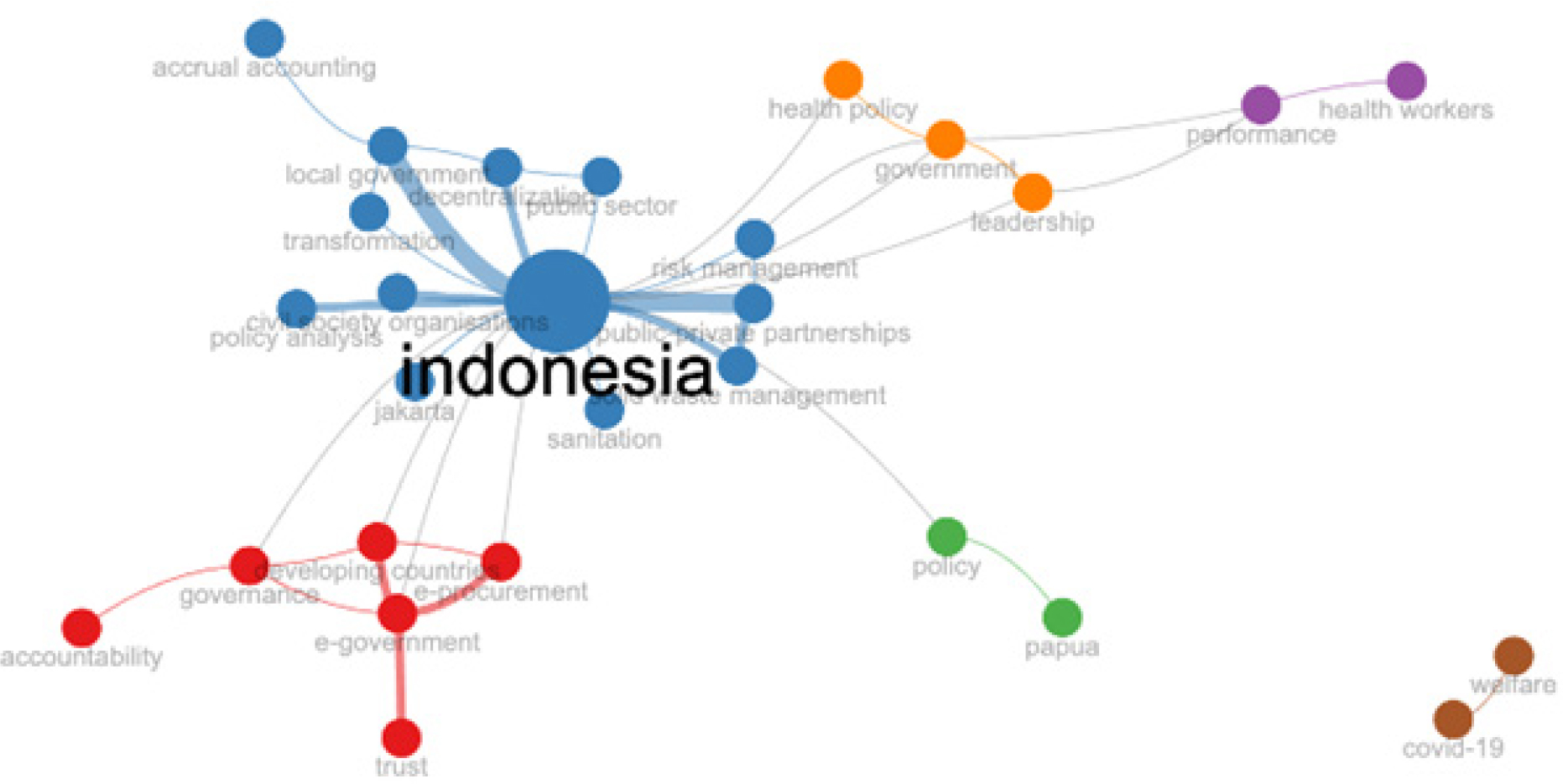
Figure 10:
Co-Occurrence Network.
An analysis of co-occurrence networks based on author keywords reveals thematic clusters in research on Indonesian public administration. The keywords “e-government,” “governance,” “developing countries,” “e-procurement,” and “accountability” in Cluster 1 are interconnected, suggesting a comprehensive investigation of electronic governance, governance structures and the challenges faced by developing nations. Figure 10, that this cluster is bold, indicates how the sub-topic. One of leading study brought by Wahid and Sein who proposing improved e-procurement deployment in Indonesia and sharing lessons from a successful scenario that reduced corruption by e-procurement.[35] Cluster 2 encompasses a range of governance and public sector topics in Indonesia, including keywords such as “government”, “health policy” and “leadership”.
Cluster 3 encompasses keywords such as “health workers,” “performance,” and suggesting a concentration on the human aspects of public administration, specifically the motivation and performance of healthcare workers. Cluster 4 keywords, such as “policy,” “Papua,” suggest a specific emphasis on the governance of policy and local government. Cluster 5 comprises keywords such as “transformation”, “accrual accounting”, “local government”, “decentralization” which emphasize research on the transformation of public administration organizations and accounting. The research that contributed to this issue is the study Indonesian local governments’ implementation of accrual basis accounting after Government Regulation (GR) Number 71 of 2010 mandated it by identification of important actors.[36] Cluster 6 encompasses the topics of “COVID-19” and “welfare,” suggesting a specific emphasis on research related to the pandemic and social welfare. The co-occurrence network illustrates the diverse, intricate and adaptable nature of public administration research in Indonesia, which addresses both local and global challenges.
Thematic evolution
In Figure 11, we display thematic evolution to provide insight into how the research focus on public administration in Indonesia has shifted over time using Keyword Plus from data extraction. During the first period, the most prevalent topics were “behavior”, “development”, “factors”, “health” and “Indonesia”. Nonetheless, this begins to change as we enter the subsequent historical period. For instance, “behavior” shifts its emphasis to “effect” in the Indonesian context, while “development” shifts its emphasis to “development” During the same period, “factors” transferred its emphasis to the “public” sector, while “health” remained an important topic but is now more focused on “health care”. The Indonesian context remains the primary topic of discussion, but there is now a greater emphasis on “government”, “performance”, “impact”, “public sector”, “role” and “social”.
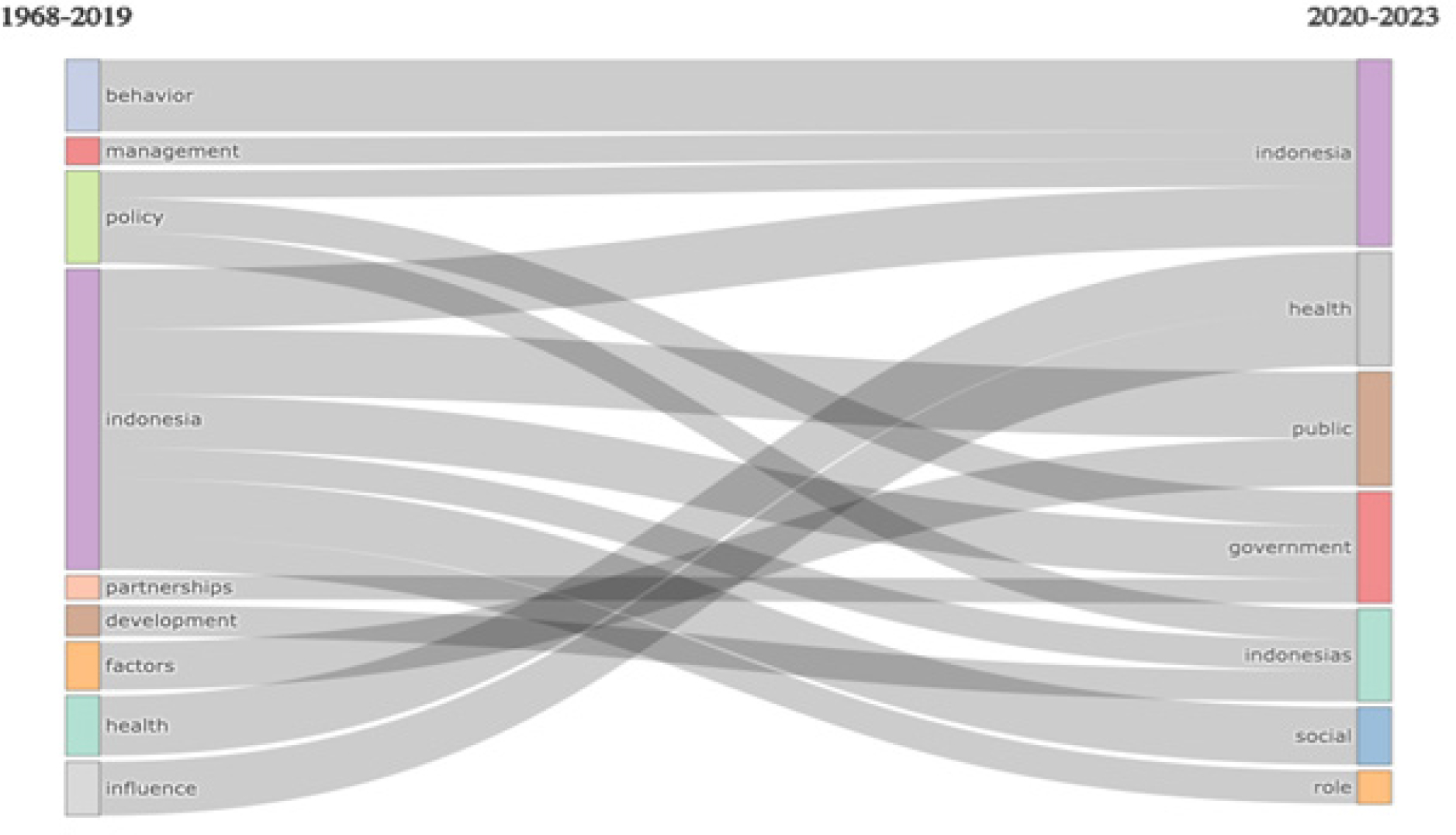
Figure 11:
Thematic evolution.
In addition, there is a new emphasis on “workers” in the context of “health” and “legal” is discussed in the context of “government”. The issue of health problems remains a significant focus in public administration research in Indonesia. Initially, this issue centered around the administration and the inadequate number and competence of healthcare professionals, which continues to be a nationwide challenge.[37–39] Subsequently, the most recent research was revisited in light of the worldwide pandemic, with an emphasis on controlling the transmission of COVID-19 and the alterations in work routines caused by COVID-19.[40,41] Similarly, “policy” remains an important topic, but the emphasis is now on “governance”, “model”, “policy” and “Indonesia”. Nevertheless, it is essential to recognize that these time divisions are not rigid and immutable classifications, but rather depictions of broad trends and patterns. Many topics may be applicable across time periods and there may be overlap between the various research fields.
Collaboration
The collaboration map illustrates the extent to which Indonesia has collaborated with other nations on public administration studies in Figure 12 and Table 5.
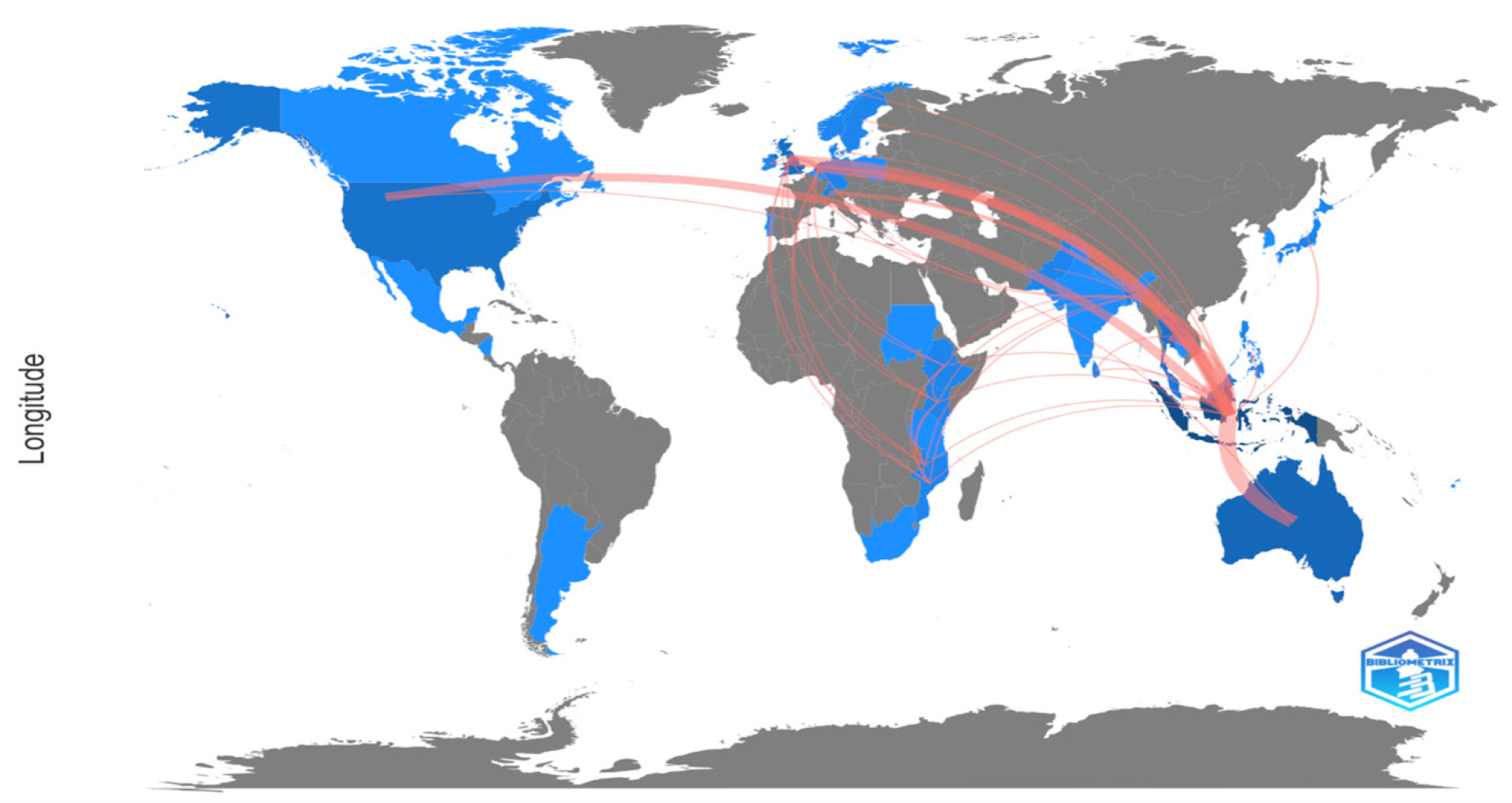
Figure 12:
Collaboration map.
| From | To | Frequency |
|---|---|---|
| Indonesia | Australia | 14 |
| Indonesia | United Kingdom | 13 |
| Indonesia | Thailand | 8 |
| Indonesia | Netherlands | 7 |
| Indonesia | Usa | 6 |
| Indonesia | Malaysia | 4 |
| Indonesia | Bangladesh | 3 |
| Indonesia | Pakistan | 3 |
| Indonesia | Singapore | 3 |
| Indonesia | Switzerland | 3 |
| Netherlands | United Kingdom | 3 |
Analysis of this collaboration’s frequency reveals varying degrees of engagement with other nations. Australia appears to have the highest level of collaboration with Indonesia, followed by the United Kingdom and the Netherlands. Additionally, there are substantial partnerships with the United States and Thailand. This number reflects the research emphasis and priority, as well as the political and historical ties between these nations and Indonesia. However, international cooperation is not limited to Western nations or regional neighbors. There are indications of collaboration with Bangladesh, Ethiopia, Malawi and Mozambique. This demonstrates that public administration in Indonesia incorporates diverse global perspectives and methodologies.
DISCUSSION
This study provides an overview of the status and growth of public administration research in Indonesia through a number of critical findings. The findings of this study accentuate towards an impressive increase in research output and citation in public administration studies in Indonesia as shown in Figure 1 and Figure 2. If the number of publications since 2006 has increased noticeably, then in recent years, the average citation per article has dropped; thus, although research production may be on the rise, not all publications exert significant influence within the global academic community.[42–44] Nonetheless, according to research conducted by Walker et al., (2014) Indonesia’s research output is still modest in comparison to China, Japan and Hong Kong.[45] This demonstrates that despite significant improvements, Indonesia has a great deal of room for development in the production of public administration research. Moreover, a view of the bibliometric dataset is provided in Table 1, for the public administration research in Indonesia showing an annual growth rate of 4.62%, while 122 documents were analyzed between 1968 and 2023. The average citation per document of 9.96 signifies a reasonable degree of influence; however, this is still considerably below the international mean for public administration research. Also, the104 keywords from Identifiers (ID) Plus and 480 author-provided keywords indicate a wide variety of thematic coverage of this field.
Analysis of journal impact depicted in Table 3 shows that Human Resources for Health, Transforming Government: People, Process and Policy, and Asia and the Pacific Policy Studies are among the most prominent communication channels of public administration research in Indonesia. While journals with a higher number of publications enjoy substantial influence, other journals with fewer publications but with high citation rates demonstrate that impact does not necessarily correlate with volume of publication. In addition, this study emphasizes the significance of influential sources and authors in public administration research. Important journals such as “Administrative Science Quarterly” and “Public Administration Review” have contributed significantly to research in this field. This trend is consistent with the findings of a study conducted by Walker et al., (2014) which demonstrates the significance of researchers having access to high-quality sources in order to conduct innovative and influential research.[45]
Also, identifying the key contributors is an important aspect of bibliometric analysis. Figure 4 demonstrates that Achmad Nizar Hidayanto and Achmad Nurmandi constitute major authors with high-citation publications, confirming their role in shaping public administration discourse in Indonesia. Major institutions are further illustrated in Figures 5 and 6, with Universitas Gadjah Mada standing out as the leading contributor, closely followed by Universitas Muhammadiyah Yogyakarta and Universitas Indonesia. Increasing involvement from multiple institutions reflects a greater interest in public administration research in Indonesia. According to the study Walker et al., (2014) Indonesian researchers are underrepresented in the publication of high-impact journals, with only 12 articles submitted to journals with high citation scores.[45] During the study period, only 122 articles written by Indonesian researchers were published in high-impact journals, indicating that the situation is far from optimal. This indicates that, despite the rise in the number of studies and citations, there is significant space for improvement in the quality and frequency of Indonesian researchers’ participation in journals with high citation scores.[46–48] In addition, additional efforts are required to promote diversity among authors and increase the participation of young and early-career researchers in public administration research. This study, along with others, demonstrates that this is a crucial stage in ensuring the growth and sustainability of this field.[47,49,50] Here, international collaboration has impacted the development of research. Figures 12 and 5 show that the strongest partner countries for Indonesia’s collaboration in conducting research are Australia, the United Kingdom, the Netherlands, and the USA. Research partnerships were formed with countries such as Bangladesh, Ethiopia, Malawi, and Mozambique. This level of collaboration signifies the international importance of Indonesian public administration research and that international networking plays a role in disseminating knowledge.
The study highlights important research clusters, such as electronic governance; human aspects of public administration; local government; and transformation of public administration organizations and accounting. Based on the research by Kim et al., (2019) on public administration research in China focuses primarily on organizational theory, finance and budgeting, social welfare, public policy, performance management and the environment.[51] This study’s findings indicate that the majority of research on Chinese public administration focuses on traditional public management. This comparison illustrates the disparities in public administration research priorities and foci between Indonesia and China. Nonetheless, both exhibit a passion for researching key issues pertinent to contemporary challenges and advancements in public administration. In addition, this finding demonstrates that, despite some distinctions, there are also some similarities between the issues studied, such as an emphasis on social change, development and public policy.
Compared to previous studies that focused on public administration in East and Southeast Asia, it appears that research on Indonesia and Indonesia has a different emphasis.[45] In East and Southeast Asia, management reform, social policy, environmental policy, economic policy and health policy are the predominant research topics. In the meantime, research in Indonesia focuses primarily on economic development, health and human resource issues, health policy and governance in developing nations and decentralization and e-governance as seen on the co-occurrence network in Figure 10. The idea of e-government is in parallel with global trends emphasizing digital transformation in public administration. (Table 4) such as Larson’s study of decentralization and forest management are, indeed, the most typically cited of works concerning a topic in Indonesia.[52] Here, the governance and environmental public policy long considered salient in Indonesian public administration discourse. The co-citation, in turn, of papers such as those about community health-worker motivation,[53] and e-government adoption,[54] perhaps, imply that there is significant interest in public service efficiency and technological transformation.
Over time, research in East and Southeast Asia has shifted from social policy and management reforms to more specific environmental and economic concerns.[45] In Indonesia, the focus of research shifts from topics such as “behavior”, “development”, “factors”, “health” and “Indonesia” to “effects”, “public sector”, “health care”, “government”, “performance”, “impact”, “role” and “social” (see: Figure 11). Western influence appears to have persisted in both regions, albeit in distinct ways Several studies in East and Southeast Asia have attempted to determine the scope of Western influence on management reform and social policy. While there is no particular emphasis on Western influence in public administration research in Indonesia, research collaborations with Western researchers indicate interaction with Western thought and practice.[45] Both candidates have demonstrated a focus on health policy, albeit with distinct approaches. Typically, research in East and Southeast Asia focuses on more specific policy concerns. In contrast, research in Indonesia emphasizes more on health issues and human resources in general. In contrast, research in Indonesia places a greater emphasis on decentralization and governance than in East and Southeast Asia.[45] This reflects the historical, cultural and sociopolitical context differences between East and Southeast Asia in general and Indonesia in particular.
Reflected on the global research in public administration,[11] find that the level of collaboration in the field of Public Administration (PA) remains lower compared to some disciplines in the social sciences.[11] Our findings align with the observed growth of international research collaboration in the field of public administration in Indonesia. Examining the progress of public administration studies in Indonesia, it aligns with a global study conducted by[12] where their research reveals that the primary subtopics discussed in public administration are policy issues, management and performance and matters pertaining to state and local management.[55] Nevertheless, numerous intriguing matters are examined within various subtopics.[56] Utilizes cultural materialism, Williams’ keyword analysis and Sum and Jessop’s cultural political economy to critically examine the concept of “policy” in the context of Indonesia.[57] Regarding management and performance,[58] examine the impact of perceived organizational support, job motivation and affective commitment on the performance and career development of public sector employees in the Ministry of Finance of Indonesia using a case study.[59] Addressing local government issues, there is compelling research by that reveals the influence and structural disparities that contribute to challenges and unfavorable outcomes in municipal digitalization agendas. The major flaws in digitization governance are horizontal sectoral ego and vertical asymmetry and misalignment. This demonstrates the potential for the expansion of public administration research in Indonesia across various topics, which aligns with the global development of public administration.
LIMITATIONS
As a scientific investigation, this research has limitations. First, this study only encompasses English-language publications. Consequently, research published in other languages or in regional journals may not be completely reflected in this analysis, which may have implications for the interpretation of public administration research developments in Indonesia. Second, despite the use of multiple data sources and analytical techniques, it is possible that some relevant studies were omitted from this analysis, particularly those published in lesser-known journals or those with low citation counts.
FUTURE DIRECTIONS
Regarding prospective research directions, there are numerous areas that could be investigated further. To gain a better understanding of how these topics develop and interact within the context of public administration in Indonesia, researchers can first conduct more in-depth research on the research topics and clusters identified in this study. Second, researchers can investigate the causes of the rise in the number of studies and citations from Indonesia in order to determine how this can be enhanced. Thirdly, there is a chance to conduct additional research on the impact and function of international collaboration in research on public administration in Indonesia. By continuing research in this area, we can aspire to gain a deeper understanding of public administration research developments in Indonesia and contribute to the formation of future research directions.
CONCLUSION
This study provides a thorough and in-depth analysis of public administration research in Indonesia, as well as an overview of its status and recent developments. It has been revealed in this study that there is a very steady incline in output and the number of citations. This emphasizes that research from Indonesia is increasingly contributing to academic development in the field. However, while numbers have increased in terms of research, impact is found to be disparate and many of them receive poor citations in comparison with international standards. The analysis recognizes key contributors, among them being eminent journals, influential authors, and dominant institutions. A few universities and government agencies continue to significantly influence the research direction, reiterating the need for much broader institutional engagement. International collaboration has played a very major role in knowledge production, establishing strong partnerships with countries like Australia, the UK, and the Netherlands. The increasing involvement of researchers from developing countries is itself an indication of the diversification of research networks. There is an observable shift in themes-from an early concentration on governance and bureaucratic efficiency in research to current approaches that focus on digital governance, e-government, decentralization, and public sector innovation. These currents reflect an evolving policy landscape in Indonesia and resonate with global discourses concerning public administration transformation through digital avenues. Nonetheless, inequalities in terms of funding for studies and visibility continue to be an impediment to success and therefore demand more institutional support for actionable study and policy-relevant research. Given the achievements, improvement is still required in boosting study quality, strengthening international collaboration, and providing consideration to underexplored areas. Strengthening collaboration across sectors, increasing access to high-impact journals, and fostering interdisciplinary research can further augment the stature of Indonesia in public administration scholarship. In addition, future research should analyze how digitalization, governance reforms, and international partnerships shape the future of public administration in Indonesia, providing policy-relevant insights from academic endeavors.
Cite this article:
Santoso AD, Sajida. Bibliometric Insights into Public Administration in Indonesia: A Study of 50 Leading Journals. J Scientometric Res. 2025;14(2):559-572.
ACKNOWLEDGEMENT
The authors would like to express their gratitude to the editor and the anonymous reviewers for their insightful comments and suggestions, which have greatly improved the quality of this article. The first author, Anang, extends his appreciation to the Indonesian Endowment Fund for Education (LPDP) for providing the scholarship that supported his research.
References
- Fenwick J, McMillan J. Public administration: what is it, why teach it and does it matter?. Teach Public Admin. 2014;32(2):194-204. [CrossRef] | [Google Scholar]
- Davis M. Is public administration a profession?. Public Admin Res. 2013;2(2) [CrossRef] | [Google Scholar]
- Elliott IC, Bottom KA, Carmichael P, Liddle J, Martin S, Pyper R, et al. The fragmentation of public administration: differentiated and decentered governance in the (dis)United Kingdom.. Public Admin.. 2022;100(1):98-115. [CrossRef] | [Google Scholar]
- Hillman B. Public administration reform in post-conflict societies: lessons from Aceh, Indonesia.. Public Admin Dev.. 2013;33(1):1-14. [CrossRef] | [Google Scholar]
- Moon MJ, Hwang C. The state of civil service systems in the Asia-Pacific region: A comparative perspective.. Rev Public Pers Admin.. 2013;33(2):121-39. [CrossRef] | [Google Scholar]
- Uhaib M, Djani W. Indonesia public administration reform in supporting good governance.. Rev Public Admin Manag.. 2018;6(3) [CrossRef] | [Google Scholar]
- Turner M, Prasojo E, Sumarwono R. The challenge of reforming big bureaucracy in Indonesia.. Policy Stud.. 2022;43(2):333-51. [CrossRef] | [Google Scholar]
- Fowler L, Fox D. Is Florida really that interesting? State geographic bias in public administration research.. State Local Gov Rev.. 2023;55(1):62-72. [CrossRef] | [Google Scholar]
- McDonald BD, Hall JL, O’Flynn J, van Thiel S. The future of public administration research: an editor’s perspective. Public Admin. 2022;100(1):59-71. [CrossRef] | [Google Scholar]
- Elías MV. Practice as lived experience: the missing link in public administration research. Public Admin Q.. 2022;46(1):67-88. [CrossRef] | [Google Scholar]
- Yu Z. Development of public administration research with a bibliometric analysis [sci program]. Scientific Programming. 2022;2022:1-19. [CrossRef] | [Google Scholar]
- Abdolhamid M, Amiri MR, Abdolhoseinzadeh M, Givi ME, Mirezati SZ, Saberi MK, et al. Bibliometric analysis of global scientific research on Public Administration: 1923-2020.. Int J Inf Sci Manag.. 2023;21(1):73-94. [CrossRef] | [Google Scholar]
- Cuccurullo C, Aria M, Sarto F. Foundations and trends in performance management.. A twenty-five years bibliometric analysis in business and public administration domains. Scientometrics.. 2016;108(2):595-611. [CrossRef] | [Google Scholar]
- Thompson DF, Walker CK. A descriptive and historical review of bibliometrics with applications to medical sciences.. Pharmacotherapy.. 2015;35(6):551-9. [PubMed] | [CrossRef] | [Google Scholar]
- Zupic I, Čater T. Bibliometric methods in management and organization. Organ Res Methods. 2015;18(3):429-72. [CrossRef] | [Google Scholar]
- Donthu N, Kumar S, Mukherjee D, Pandey N, Lim WM. How to conduct a bibliometric analysis: an overview and guidelines.. J Bus Res.. 2021;133:285-96. [CrossRef] | [Google Scholar]
- Melles SJ, Scarpone C, Julien A, Robertson J, Levieva JB, Carrier C, et al. Diversity of practitioners publishing in five leading international journals of applied ecology and conservation biology, 1987-2015 relative to global biodiversity hotspots.. Ecoscience.. 2019;26(4):323-40. [CrossRef] | [Google Scholar]
- Okumus F, Köseoglu MA, Putra ED, Dogan IC, Yildiz M. A bibliometric analysis of lodging-context research from 1990 to 2016.. J Hosp Tourism Res.. 2019;43(2):210-25. [CrossRef] | [Google Scholar]
- Ndou V, Rampedi IT. Bibliometric analysis of municipal solid waste management research: global and South African trends.. Sustainability.. 2022;14(16) [CrossRef] | [Google Scholar]
- Ng JY, Chang N. A bibliometric analysis of the cannabis and cannabinoid research literature.. J Cannabis Res.. 2022;4(1):25 [PubMed] | [CrossRef] | [Google Scholar]
- Aria M, Cuccurullo C. bibliometrix: an R-tool for comprehensive science mapping analysis.. J Informetr.. 2017;11(4):959-75. [CrossRef] | [Google Scholar]
- Santoso AD, Sajida S, Yusnaini Y. Forest tourism in Southeast Asia: A bibliometric analysis.. Forest Soc.. 2024;8(2):484-502. [CrossRef] | [Google Scholar]
- Ormel H, Kok M, Kane S, Ahmed R, Chikaphupha K, Rashid SF, et al. Salaried and voluntary community health workers: exploring how incentives and expectation gaps influence motivation.. Hum Resour Health.. 2019;17(1):59 [PubMed] | [CrossRef] | [Google Scholar]
- Ananta A, Utami DR, Handayani NB. Statistics on ethnic diversity in the land of Papua, Indonesia.. Asia Pac Policy Stud.. 2016;3(3):458-74. [CrossRef] | [Google Scholar]
- Kusumasari B, Sajida S, Santoso AD, Fauzi FZ. The Reinventing of public administration in the new hybrid world.. Teach Public Admin.. 2024;42(2):206-29. [CrossRef] | [Google Scholar]
- Sayogo DS, Yuli SB, Amalia FA. Data-driven decision-making challenges of local government in Indonesia.. Transform Gov People Process Policy.. 2024;18(1):145-56. [CrossRef] | [Google Scholar]
- Taufiq M, Suhirman S, Sofhani TF, Kombaitan B. Power dynamics in collaborative rural planning: the case of Pematang Tengah, Indonesia.. Environ Plann C Polit Space.. 2022;40(7):1515-34. [CrossRef] | [Google Scholar]
- Sondang Siagian E, Sumaryana A, Widianingsih I, Nurasa H. Public-private partnerships in solid waste management in Indonesia: the need for technical regulation.. Asia Pac J Public Admin.. 2019;41(4):246-50. [CrossRef] | [Google Scholar]
- Hou X, Witter S, Zaman RU, Engelhardt K, Hafidz F, Julia F, et al. What do health workers in Timor-Leste want, know and do? Findings from a national health labour market survey.. Hum Resour Health.. 2016;14:1 [CrossRef] | [Google Scholar]
- Gorris P, Glaser M, Idrus R, Yusuf A. The role of social structure for governing natural resources in decentralized political systems: insights from governing a fishery in Indonesia.. Public Admin.. 2019;97(3):654-70. [CrossRef] | [Google Scholar]
- Purwanti Y, Purwanto BH, Jamaludin M. Citizen Participation in Electronic Public Administration. The considerations of functionality and the technology acceptance model. Int J Public Policy Admin Res.. 2023;9(4):90-101. [CrossRef] | [Google Scholar]
- Wahid F, Sein MK. Institutional entrepreneurs: the driving force in institutionalization of public systems in developing countries.. Transform Gov People Process Policy.. 2013;7(1):76-92. [CrossRef] | [Google Scholar]
- Yuliati R, Yuliansyah Y, Adelina YE. The implementation of accrual basis accounting by Indonesia’s local governments.. Int Rev Public Admin.. 2019;24(2):67-80. [CrossRef] | [Google Scholar]
- Basri C, Bergström K, Walton W, Surya A, Voskens J, Metha F, et al. Sustainable scaling up of good quality health worker education for tuberculosis control in Indonesia: a case study.. Hum Resour Health.. 2009;7:85 [PubMed] | [CrossRef] | [Google Scholar]
- Heywood PF, Harahap NP. Human resources for health at the district level in Indonesia: the smoke and mirrors of decentralization.. Hum Resour Health.. 2009;7:6 [PubMed] | [CrossRef] | [Google Scholar]
- Heywood P, Harahap NP, Aryani S. Recent changes in human resources for health and health facilities at the district level in Indonesia: evidence from 3 districts in Java.. Hum Resour Health.. 2011;9:5 [PubMed] | [CrossRef] | [Google Scholar]
- Basuki B, Szczepańska-Woszczyna K, Rajiani I, Widyanti R, Kot S. Working from home arrangement in delivering public service during the COVID-19 pandemic: innovation or irritation?. Admin Si Manag Public.. 2022;1(39):26-39. [CrossRef] | [Google Scholar]
- Nasution BI, Nugraha Y, Sulasikin A, Wiguna H, Kanggrawan JI, Suherman AL, et al. An evidence-based culture: COVID-19 positivity factors during the asymptomatic occurrence in Jakarta, lndonesia.. Sci Public Policy.. 2022;49(1):115-26. [CrossRef] | [Google Scholar]
- Moloney K, Rosenbloom DH. Creating space for public administration in international organization studies.. Am Rev Public Admin.. 2020;50(3):227-43. [CrossRef] | [Google Scholar]
- Ospina SM, Esteve M, Lee S. Assessing qualitative studies in public administration research.. Public Admin Rev.. 2018;78(4):593-605. [CrossRef] | [Google Scholar]
- Drechsler W. Public administration studies: the digital trajectory. Transylvanian Rev Admin Sci. 2022;2022((SI) Special Issue):40-51. [CrossRef] | [Google Scholar]
- Walker RM, Brewer GA, Choi Y. Public administration research in East and Southeast Asia: a review of the English language evidence, 1999-2009.. Am Rev Public Admin.. 2014;44(2):131-50. [CrossRef] | [Google Scholar]
- Randma-Liiv T. Demand- and supply-based policy transfer in Estonian public administration. J Balt Stud. 2005;36(4):467-87. [CrossRef] | [Google Scholar]
- Muhafidin D. Improving quality of higher education using academic information system as a public administration service: the case of Indonesia.. J Soc Stud Educ Res.. 2020;11(1):127-36. [CrossRef] | [Google Scholar]
- Cheng JY, Lu LQ. Public administration research issues in China: evidence from content analysis of leading Chinese public administration journals.. Issues Stud.. 2009;45(1):203-41. [CrossRef] | [Google Scholar]
- Werlin H. Bottlenecks to developments: studies from the world bank’s economic development institute.. Public Admin Dev.. 1991;11(3):189-91. [CrossRef] | [Google Scholar]
- Nurmandi A, Almarez D, Roengtam S, Salahudin JHD, Kusuma Dewi DS. To what extent is social media used in city government policy making? Case studies in three ASEAN cities.. Public Policy Admin.. 2018;17(4):600-18. [CrossRef] | [Google Scholar]
- Kim MH, Li H, Holzer M, Zhang M. Public administration research in mainland China: A systematic review of Chinese public administration in English language journals (1996-2016).. Int J Public Admin.. 2019;42(9):753-64. [CrossRef] | [Google Scholar]
- Larson AM. Decentralisation and forest management in Latin America: towards a working model.. Public Admin Dev.. 2003;23(3):211-26. [CrossRef] | [Google Scholar]
- Nulhusna R, Sandhyaduhita PI, Hidayanto AN, Phusavat K. The relation of e-government quality on public trust and its impact on public participation.. Transform Gov People Process Policy.. 2017;11(3):393-418. [CrossRef] | [Google Scholar]
- Abdolhamid M, Abdolhoseinzadeh M, Esmaeili Givi M, Saberi MK, Mirezati SZ, Amiri MR, et al. Bibliometric analysis of global scientific research on Public Administration: 1923-2020.. Int J Inf Sci Manag (IJISM).. 2023;21(1):75-96. [CrossRef] | [Google Scholar]
- Sakhiyya Z. Problematizing policy: a semantic history of the word ‘policy’ in the Indonesian language.. Crit Policy Stud.. 2022;16(4):389-404. [CrossRef] | [Google Scholar]
- Napitupulu S, Haryono T, Laksmi Riani A, Sawitri HS, Harsono M. The impact of career development on employee performance: an empirical study of the public sector in Indonesia.. Int Rev Public Admin.. 2017;22(3):276-99. [CrossRef] | [Google Scholar]
- Ramadani L, Yovadiani A, Dewi F. When innocence is no protection: governance failure of digitization and its impact on local level implementation.. Transform Gov People Process Policy.. 2022;16(1):68-80. [CrossRef] | [Google Scholar]
- Giessen L, Burns S, Sahide MA, Wibowo A. From governance to government: the strengthened role of state bureaucracies in forest and agricultural certification.. Policy Soc.. 2016;35(1):71-89. [CrossRef] | [Google Scholar]
- Batara E, Nurmandi A, Warsito T, Pribadi U. Are government employees adopting local e-government transformation? The need for having the right attitude, facilitating conditions and performance expectations.. Transform Gov People Process Policy.. 2017;11(4):612-38. [CrossRef] | [Google Scholar]
- Eckardt S. Political accountability, fiscal conditions and local government performance-cross‐sectional evidence from Indonesia. Public administration and development. Int J Manag Res Pract.. 2008;28(1):1-17. [CrossRef] | [Google Scholar]
- Inasius F. Factors influencing SME tax compliance: evidence from Indonesia.. Int J Public Admin.. 2019;42(5):367-79. [CrossRef] | [Google Scholar]
- Erdenee O, Paramita SA, Yamazaki C, Koyama H. Distribution of health care resources in Mongolia using the Gini coefficient.. Hum Resour Health.. 2017;15(1):56 [PubMed] | [CrossRef] | [Google Scholar]

